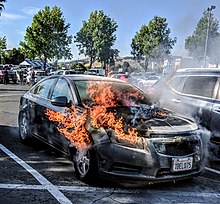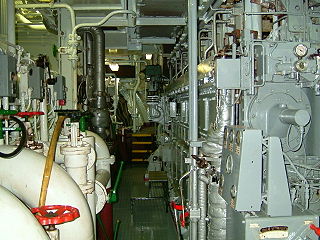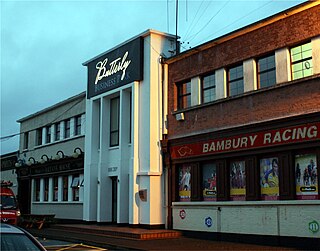

A vehicle fire is an undesired conflagration (uncontrolled burning) involving a motor vehicle. Also termed car fire, it is one of the most common causes of fire-related property damage.


A vehicle fire is an undesired conflagration (uncontrolled burning) involving a motor vehicle. Also termed car fire, it is one of the most common causes of fire-related property damage.

A motor vehicle contains many types of flammable materials, including flammable liquids like gasoline and oil as well as solid combustibles such as hose. Fuel leaks from ruptured fuel lines also can rapidly ignite, especially in petrol fuelled cars where sparks are possible in the engine compartment. Fires with casualties have been caused by ozone cracking of nitrile rubber fuel lines for example.[ citation needed ]
Vehicles house multiple potential sources of ignition including electrical devices that may short circuit, hot exhaust systems, and modern car devices such as air bag detonators.[ citation needed ]
It is often the case in accidental auto fires that the bulk of the fire is (at least initially) contained in the engine compartment of the vehicle. In most vehicles, the passenger compartment is protected from engine compartment fire by a firewall. However, in case of arson, the fire does not always start in the interior or spread there. It is mandatory to carry an in-car fire extinguisher in some countries, such as Belgium, Bulgaria and Poland. [2] [ better source needed ]
From 2003 to 2007 in the United States, there were 280,000 car fires per year, which caused 480 deaths. [3]

In the UK, accidental car fires are declining [4] but deliberate car fires (arson) are increasing. There are approximately the same number of deliberate car fires as there are accidental car fires in the UK. It is common for joyriders to set fire to stolen cars: abandoned cars are commonly set on fire by vandals. Around two cars out of every thousand registered in the UK catch fire each year. [5] [6]
In France, widespread arson of cars is regularly committed by youths during New Year's Eve celebrations. This began during the 1990's in poorer areas of Strasbourg, but has since spread nation-wide. [7]
In Sweden, a pattern has emerged in recent years of cars being set on fire by youths in the summer, towards the end of the school summer holidays. [8]
While some cases of deliberate car fires are isolated incidents, committed clandestinely, the practice is publicly performed by either rioters and revelers, with little to no retribution. Some tragic vehicle fires have received wide publicity, some evidently due to accident or mechanical or electrical problems, and other due to crimes.[ citation needed ]

A Molotov cocktail is a hand-thrown incendiary weapon constructed from a frangible container filled with flammable substances equipped with a fuse. In use, the fuse attached to the container is lit and the weapon is thrown, shattering on impact. This ignites the flammable substances contained in the bottle and spreads flames as the fuel burns.

The Ford Pinto is a subcompact car that was manufactured and marketed by Ford Motor Company in North America from 1971 until 1980. The Pinto was the first subcompact vehicle produced by Ford in North America.

A catalytic converter is an exhaust emission control device that converts toxic gases and pollutants in exhaust gas from an internal combustion engine into less-toxic pollutants by catalyzing a redox reaction. Catalytic converters are usually used with internal combustion engines fueled by gasoline or diesel, including lean-burn engines, and sometimes on kerosene heaters and stoves.

A jump start, also called a boost, is a procedure of starting a motor vehicle that has a discharged battery. A temporary connection is made to the battery of another vehicle, or to some other external power source. The external supply of electricity recharges the disabled vehicle's battery and provides some of the power needed to crank the engine. Once the vehicle has been started, its normal charging system will recharge, so the auxiliary source can be removed. If the vehicle charging system is functional, leaving the engine running will restore the charge of the battery.

A lighter is a portable device which creates a controlled flame, and can be used to ignite a variety of flammable items, such as cigarettes, butane gas, fireworks, candles or campfires. A lighter typically consists of a metal or plastic container filled with a flammable liquid, a compressed flammable gas and in rarer cases a flammable solid i.e. rope in a trench lighter, a means of ignition to produce the flame, and some provision for extinguishing the flame or merely controlling it to such a degree that the user may extinguish it with their breath. Alternatively, a lighter can be one which uses electricity to create an electric arc utilizing the created plasma as the source of ignition or a heating element can be used in a similar vein to heat the target to its ignition temperatures, as first formally utilized by Friedrich Wilhelm Schindler to light cigars and now more commonly seen incorporated into the automobile auxiliary power outlet to ignite the target material. Different lighter fuels have different characteristics which is the main influence behind the creation and purchasing of a variety of lighter types.

Liquefied petroleum gas is a fuel gas which contains a flammable mixture of hydrocarbon gases, specifically propane, propylene, butylene, isobutane, and n-butane.
A flashover is the near-simultaneous ignition of most of the directly exposed combustible material in an enclosed area. When certain organic materials are heated, they undergo thermal decomposition and release flammable gases. Flashover occurs when the majority of the exposed surfaces in a space are heated to their autoignition temperature and emit flammable gases. Flashover normally occurs at 500 °C (932 °F) or 590 °C (1,100 °F) for ordinary combustibles and an incident heat flux at floor level of 20 kilowatts per square metre (2.5 hp/sq ft).

On a ship, the engine room (ER) is the compartment where the machinery for marine propulsion is located. The engine room is generally the largest physical compartment of the machinery space. It houses the vessel's prime mover, usually some variations of a heat engine. On some ships, there may be more than one engine room, such as forward and aft, or port or starboard engine rooms, or may be simply numbered. To increase a vessel's safety and chances of surviving damage, the machinery necessary for the ship's operation may be segregated into various spaces.
Methanol fuel is an alternative biofuel for internal combustion and other engines, either in combination with gasoline or independently. Methanol (CH3OH) is less expensive to produce sustainably than ethanol fuel, although it produces more toxic effects than ethanol and has lower energy density than gasoline. Methanol is safer for the environment than gasoline, is an anti-freeze agent, prevents dirt and grime buildup within the engine, has a higher flashpoint in case of fire, and produces horsepower equivalent to that of super high-octane gasoline. It can readily be used in most modern engines with a simple software setting tweak and occasionally a change in a cheap fuel seal or line. To prevent vapor lock in any possible circumstances due to being a simple, pure fuel, a small percentage of other fuel or certain additives can be included. Methanol (a methyl group linked to a hydroxyl group) may be made from fossil fuels or renewable resources, in particular natural gas and coal, or biomass respectively. In the case of the latter, it can be synthesized from CO2 (carbon dioxide) and hydrogen. The vast majority of methanol produced globally is currently made with gas and coal. However, projects, investments, and the production of green-methanol has risen steadily into 2023. Methanol fuel is currently used by racing cars in many countries and has seen increasing adoption by the maritime industry.

Vehicle extrication is the process of removing a vehicle from around a person who has been involved in a motor vehicle collision, when conventional means of exit are impossible or inadvisable. A delicate approach is needed to minimize injury to the victim during the extrication. This operation is usually accomplished by using chocks and bracing for stabilization and powered rescue tools and equipment, including the Jaws of Life. Standards and regulations for organizations can be found in NFPA 1670 and for individual members in 1006.

A fuel tank is a safe container for flammable fluids, often gasoline or diesel fuel. Though any storage tank for fuel may be so called, the term is typically applied to part of an engine system in which the fuel is stored and propelled or released into an engine. Fuel tanks range in size and complexity from the small plastic tank of a butane lighter to the multi-chambered cryogenic Space Shuttle external tank.

A police car is a ground vehicle used by police and law enforcement for transportation during patrols and responses to calls for service. A type of emergency vehicle, police cars are used by police officers to patrol a beat, quickly reach incident scenes, and transport and temporarily detain suspects, all while establishing a police presence and providing visible crime deterrence.
Firefighting jargon includes a diverse lexicon of both common and idiosyncratic terms. One problem that exists in trying to create a list such as this is that much of the terminology used by a particular department is specifically defined in their particular standing operating procedures, such that two departments may have completely different terms for the same thing. For example, depending on whom one asks, a safety team may be referred to as a standby, a RIT or RIG or RIC, or a FAST. Furthermore, a department may change a definition within its SOP, such that one year it may be RIT, and the next RIG or RIC.

Anthropogenic hazards are hazards caused by human action or inaction. They are contrasted with natural hazards. Anthropogenic hazards may adversely affect humans, other organisms, biomes, and ecosystems. The frequency and severity of hazards are key elements in some risk analysis methodologies. Hazards may also be described in relation to the impact that they have. A hazard only exists if there is a pathway to exposure.

The Stardust fire was a fatal fire which took place at the Stardust nightclub in Artane, Dublin, Ireland, in the early hours of 14 February 1981. More than 800 people were attending a disco there, of whom 48 died and 214 were injured as a result of the fire; in later years suicides of survivors and family members were also linked to the event.
Active fire protection (AFP) is an integral part of fire protection. AFP is characterized by items and/or systems, which require a certain amount of motion and response in order to work, contrary to passive fire protection.
A fire class is a system of categorizing fire with regard to the type of material and fuel for combustion. Class letters are often assigned to the different types of fire, but these differ between territories; there are separate standards for the United States, Europe, and Australia. The fire class is used to determine the types of extinguishing agents that can be used for that category.

A fire extinguisher is a handheld active fire protection device usually filled with a dry or wet chemical used to extinguish or control small fires, often in emergencies. It is not intended for use on an out-of-control fire, such as one which has reached the ceiling, endangers the user, or otherwise requires the equipment, personnel, resources or expertise of a fire brigade. Typically, a fire extinguisher consists of a hand-held cylindrical pressure vessel containing an agent that can be discharged to extinguish a fire. Fire extinguishers manufactured with non-cylindrical pressure vessels also exist but are less common.
Dry bays are the compartments immediately adjacent to fuel tanks or other flammable fluids. They frequently contain fluid lines, control lines, electrical equipment, etc. Ballistic damage to some of these bays, from penetration due to weapons fire or other causes, can allow fuel to enter the bay causing fire after contact with electrical components, and loss of the aircraft.

KMP Tampomas II was a roll on-roll off car and passenger ferry owned by the Indonesian shipping company Pelni that burned and sank in the Java Sea while sailing from Jakarta to Ujung Pandang, South Sulawesi on 27 January 1981. This disaster resulted in the deaths of hundreds of passengers.
{{cite web}}: CS1 maint: archived copy as title (link)